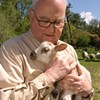Published November 26, 2003 at 2:08 p.m.
By any measure, David Muller's girls have got it good. They sleep on waterbeds in a brand-new space filled with light and fresh air. The walls inflate automatically the moment the air temperature becomes uncomfortably cool and deflate as soon as the chill is gone. The milking parlor has been specially designed to ensure that they feel no unnecessary stress during the short period each day when they are actually working, and their pasture overlooking South Woodstock has the sort of view that would make a real estate agent weep.
All the girls have to do in return is produce sinfully rich milk -- milk that has twice the butterfat content (8 percent) of the cows' milk sold in groceries, and that tops out at 4 percent butterfat in whole milk. Otherwise Muller's 80 milking water buffalo -- in a herd of 235 -- have little to do but loll on the hillside and wallow in the pond that water buffalo like to dig for themselves in warm weather.
It's Muller and the employees of his Star Hill Dairy who do the real work of making buffalo-milk yogurt and buffalo mozzarella, which are sold around Vermont and in several major metropolitan areas under the label "Woodstock Water Buffalo." He brought his first cows -- water buffalo are referred to as bulls and cows -- to the farm on Memorial Day 2002. This January, after the holiday season winds down, Muller plans to expand his distribution as far as California. And all this from a project that he never intended to happen.
"Five years ago, I bought about 300 acres in South Woodstock as a vacation place," says Muller, a graying 54-year-old physical chemist who appears to be nearly as barrel-chested and muscular as his girls. "I sat around for a while, but then I got bored, so I decided to try a small-scale agricultural project. I started doing research on the Web, and that's how I came up with water buffalo. Now, if I want to take a vacation, I have to get away from here."
Muller himself is as unusual in the agricultural community as his herd of cows with their short legs, round bodies and curved horns. His first degrees -- an M.S. and a Ph.D. -- are in physical chemistry from Cornell University. He also comes armed with an M.B.A. from the Wharton School at the University of Pennsylvania. Muller found his pot of gold as the founder of Boston-based Summit Technologies, which patented and marketed LASIK, the corrective laser eye surgery that has caught fire in recent years.
In 1997, Muller sold the company -- he doesn't say for how much, but it seems likely he did well. He's since started another company that is patenting a security device which will identify people by scanning their retinas, a technology that's still in development.
Clearly, this is a person who doesn't sit still for long. In 1998, Muller enrolled in vet school and stayed there two years, long enough to acquire a sense of confidence about the water-buffalo undertaking: "With an investment of this size, you don't just call up somebody and say, ‘Hey, do you think this will work?' There's too much riding on it."
Muller arrived at water buffalo using his marketing smarts: "It's a no-brainer to think of Vermont for artisan cheese," he says, "but I wanted to make something I like, and most of the cheeses I really like are the raw-milk cheeses from Europe, which you can't do here. Water-buffalo milk is the only milk that doesn't seem to suffer flavor changes from pasteurization. When I found that out, that was my ‘aha!' moment."
Muller determined the size of the herd by crunching the numbers. What he found was that too small an operation "would simply lose money for a long time, so I had to move beyond that. It had to be of a certain size to succeed economically."
Then the big question was whether a water buffalo, an animal most people associate with Southeast Asia, could adapt to the rigors of Vermont's climate. In fact, says Muller, water buffalo are indigenous to all parts of Asia, including the highlands of Mongolia and northern China. His research also uncovered "a thriving herd in Montana." If he had any doubts, "Last winter laid them to rest," Muller says. "The herd came through just fine."
"The local farmers all thought I was crazy," he admits. "I could see them snickering behind their hands at me. But the experts I talked to said there was no reason it couldn't work."
Muller bought his first animals in the southern U.S. -- there are sizeable herds in Florida, Arkansas and Texas, some dating back to 1978 -- and moved them north in spring 2002. By the fall, he had set to work, trying to make mozzarella from the milk. (In Italy, he says, mozzarella di bufala must be made from water-buffalo milk or it's not the real thing.) The fresh cheese is made by a process called pasta filata, whereby the curd is dipped into hot whey, then stretched and kneaded to the desired consistency, a little like pulling taffy. Then a special extrusion machine forms the cheese into balls, which is how it is sold in stores.
One night Muller took some extra milk into his kitchen to make yogurt. "I couldn't believe how good it was," he recalls. "It had nothing to do with me -- it was the buffalo milk." Hence his other major project: water-buffalo milk yogurt, which comes in a small but growing variety of flavors such as maple, black currant, cappuccino and chai. When possible, he uses Vermont products to flavor his yogurts. The black currants, for example, come from a farm in Springfield.
Muller's barn, on a hilltop above the Kedron Valley Inn, is a modern, T-shaped structure, roughly 350 feet long by 100 feet wide. He built two parts of the T last year, and plans to complete the third leg this month, at which point his girls will move indoors to their free-stall barn. The individual stalls are floored with water-filled rubber mats. When the temperature drops, a thermostat kicks on the fan that inflates the plastic siding to create air-insulated walls; as the temperature rises, the fan shuts off, allowing the walls to deflate, leaving only mesh screening in place. The milking parlor is equipped with tandem stalls that prevent the cows from jostling each other and therefore reduces stress during milking. The girls yield six or seven liters each per day -- Muller does not figure by hundredweights -- between a third and a fourth the amount a traditional domestic cow might produce.
Marketing appears to be Muller's particular strength. Backed by the Vermont image, he was able to market his yogurt with nothing more than the help of a plastic spoon. "I don't want to sound arrogant," he says, "but this is a great product. As soon as people taste it, they want more."
The mozzarella was a harder sell, he admits, mostly because "people here are so used to buffalo mozzarella that's over the hill… It should be so fresh that the curd squeaks when you bite into it. People here were used to stuff that's three weeks old and has gotten mushy."
Muller seems to be convincing people. His products are sold in New York, Boston, Philadelphia and other East Coast metro areas in stores such as Whole Foods, Bread & Circus and the Food Emporium. Shortly after Christmas, parts of California will be in the distribution network. His growth plan is "to get other farmers to raise water buffalo. They can be plugged into any of these dead or dying dairy farms that you see around. In fact, they can live with dairy cows; the herds will naturally segregate themselves."
Muller guesses he'd "pay 50 to 65 cents per pound [of milk] if someone else were making it." So far, he's had a few farmers come by to look around. "In 24 months, we've gone from mockery to intrigue to serious interest. By 2005, I'm hoping to have at least a couple of farmers on board. After all, these are just big, funny cows."
More By This Author
Speaking of...
-

Middlebury's Champlain Valley Creamery Marks 20 Years With a Milestone Cheese
Feb 27, 2024 -

Q&A: A Clinic Has Cared for Old North End Pets for Almost 20 Years
Jan 31, 2024 -

Video: The Old North End Veterinary Clinic Has Kept Costs Low to Help Pets in Burlington for Almost 20 Years
Jan 25, 2024 -

Q&A: Howard Fisher Delivers Meals on Wheels With a Side of Good Cheer
Dec 20, 2023 -

Video: Howard Fisher Delivers Meals on Wheels
Dec 14, 2023 - More »
Comments
Comments are closed.
From 2014-2020, Seven Days allowed readers to comment on all stories posted on our website. While we've appreciated the suggestions and insights, right now Seven Days is prioritizing our core mission — producing high-quality, responsible local journalism — over moderating online debates between readers.
To criticize, correct or praise our reporting, please send us a letter to the editor or send us a tip. We’ll check it out and report the results.
Online comments may return when we have better tech tools for managing them. Thanks for reading.












































